As demand for food skyrockets due to coronavirus, food banks play catch-up
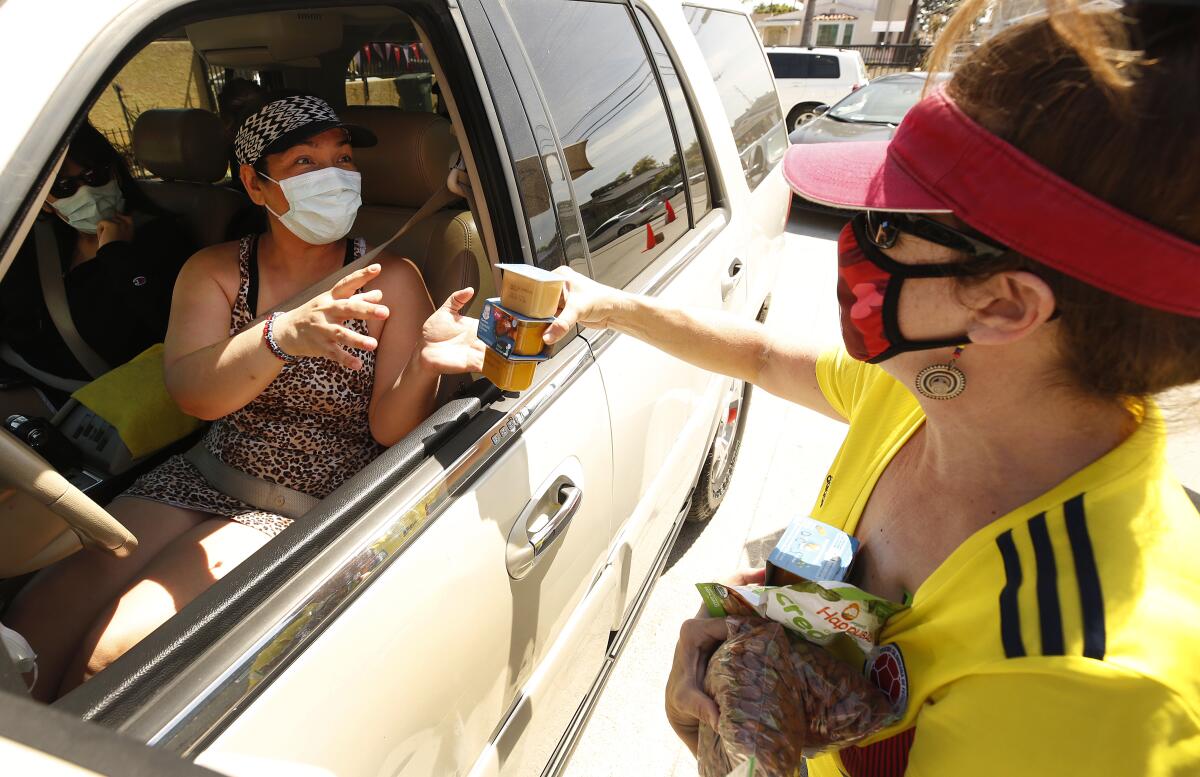
- Share via
Ofelia Jiménez didn’t think her family would need to rely on a food pantry — not again.
But after her son’s hours at McDonald’s were cut because of the COVID-19 pandemic, her husband’s $1,500 monthly pension was not enough to keep everyone fed.
The family had been coming for years to St. Margaret’s Center, a Catholic charity near the intersection of the 405 and 105 freeways, to get help with food. After Jiménez and her husband paid off their home in Inglewood, she figured she wouldn’t need to come back.
But this spring, the family again found itself struggling to pay a car note, insurance and utility bills and to buy food.

“I’ve been so worried,” said Jiménez, 60. “Without this help, I don’t know where we would be.”
Across L.A. County, a record number of families have flocked to food pantries since mid-March, as more than half the region’s residents have lost their jobs. It’s a challenge many food banks have met with remarkable agility, as the need has doubled, in some cases tripled, and a steady food supply has been harder to maintain. Some pantries have struggled with a dwindling number of volunteers; others have launched donation campaigns to buy food that they used to receive free.
The crisis has grown more dire by the week and is disproportionately impacting the community’s most vulnerable. Before the pandemic began, an estimated 1.5 million people in L.A. County were considered potentially eligible for government food assistance, according to the most recent figures available from CalFresh, the state’s nutrition assistance program.
In April, CalFresh applications skyrocketed from an average of 40,000 to nearly 120,000 a month.
“We haven’t seen this kind of increase in a long time,” said Antonia Jiménez, director of the L.A. County Department of Public Social Services. “People have lost their jobs, but they still have to put food on their table.”
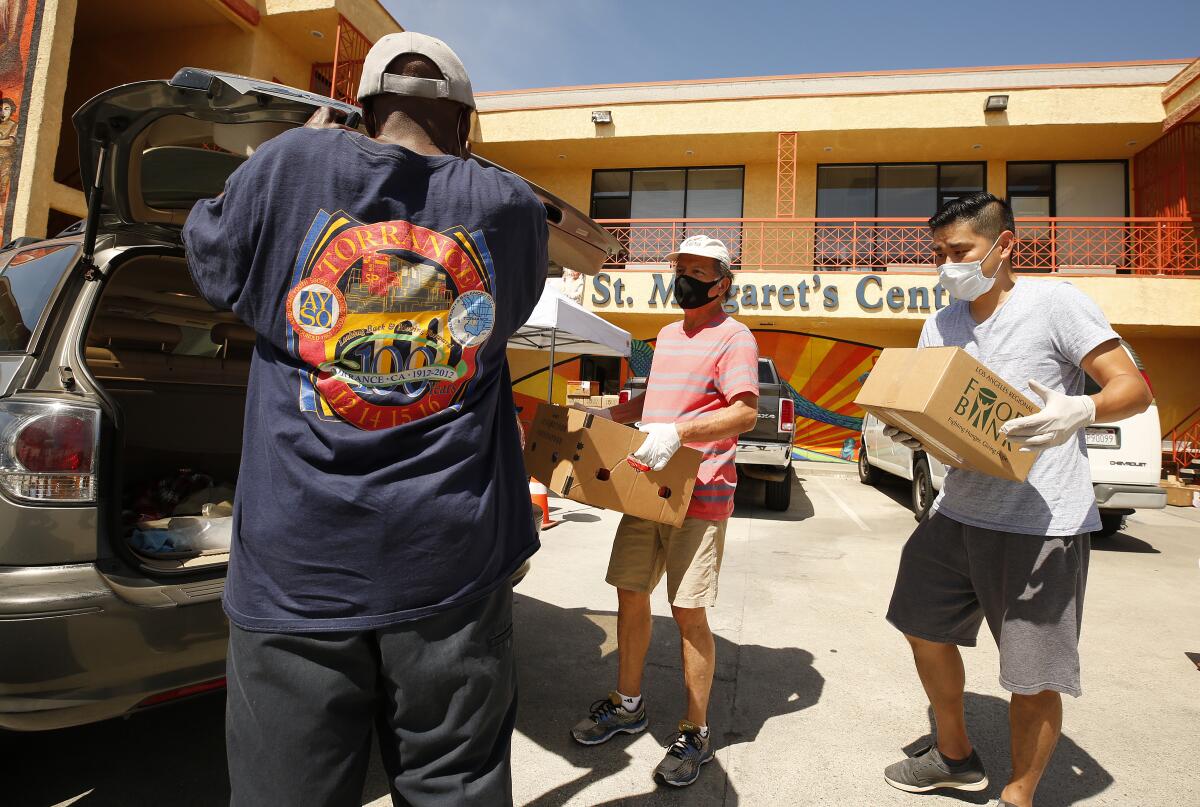
Across the country, media images have shown families waiting in miles-long traffic to pick up groceries at drive-through pantries. One of the biggest food assistance events took place April 10 at the Forum in Inglewood, an area hit hard by layoffs. Food bank officials expected about 5,000 people; more than 7,500 showed up.
“That day, it definitely sunk in just how hard the current situation was hitting so many families, how fast the fortunes had switched for some who had been OK just a few months ago,” said Michael Flood, chief executive of the Los Angeles Regional Food Bank.
The food bank oversees more than 600 food agencies across Los Angeles County. Since the pandemic brought the region to a halt in mid-March, the need for food countywide has shot up 80%, Flood said. Pantries that partner with the food bank went from serving 300,000 people to 500,000. That’s nearly twice as large a jump as the food bank saw after the economic collapse in 2008.
Within weeks, the extensive chain of food pantries that used to customize generous food boxes for families had to scale back to smaller portions, “food kits” with increasingly less variety.
Food donations have increased by 32% since the lockdown began, but that’s hardly been enough to help the Regional Food Bank catch up with demand. At distribution centers, Flood said, the five-week stockpile they began with in mid-March has diminished to a two-week supply.
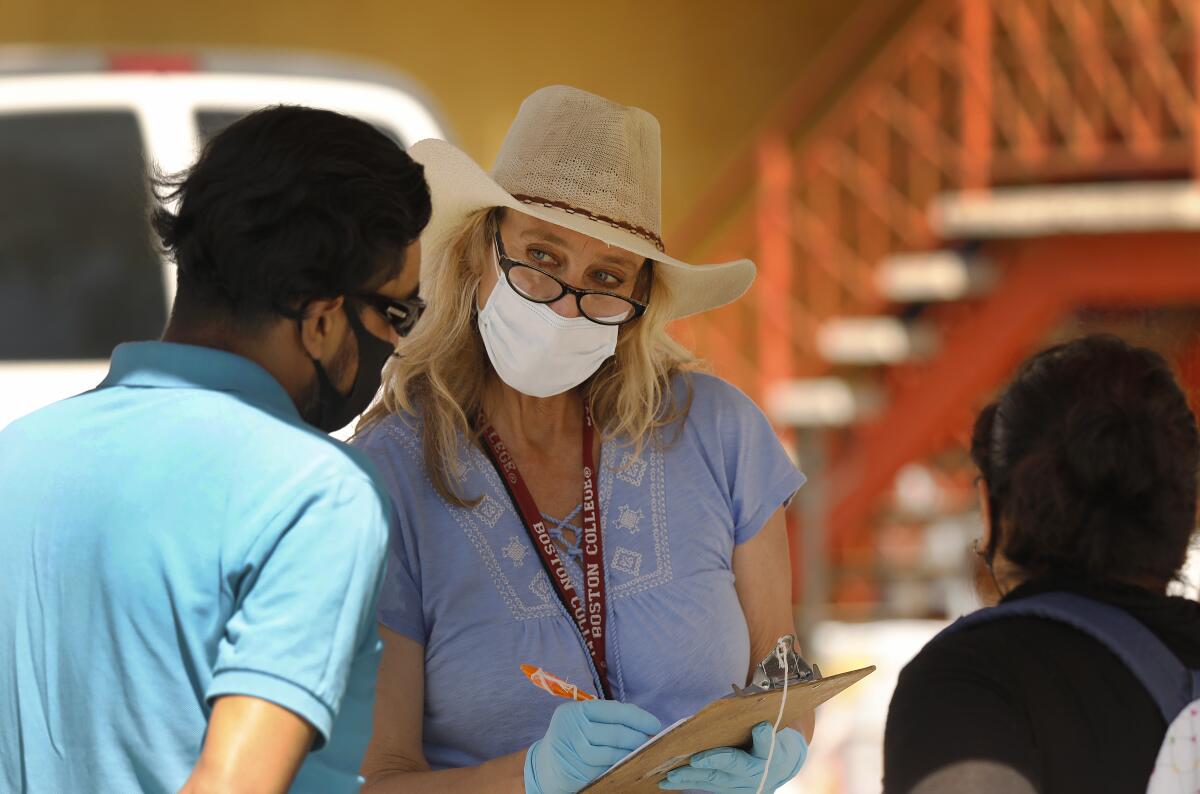
In recent weeks, the agency has had to compete in the market, paying for truckloads of food. It’s an unusual move that Flood expects will become more common as the need grows and the supply chain wrestles with disruptions.
“This is not something that’s going to go away this summer,” Flood said. “We’re going to need help, to continually appeal for funding.”
Salvation Army officials also have scrambled to find food and raise money to pay for it. The charity runs about 30 food pantries in L.A. County. Since demand skyrocketed, the organization has spent about $1 million to buy food for distribution across Southern California, most of it in Los Angeles.
“Whatever we get one day goes out the next,” said John Chamness, divisional commander for the Salvation Army’s Southern California branch. “Any organization that’s going to survive this pandemic is going to have to pivot and find new ways to serve people.”
The Salvation Army’s food bank has hustled for donations on social media, through direct mailers, on Giving Tuesday and, for the first time, via a virtual fundraiser featuring videos of such local personalities as a TV weather forecaster and a radio disc jockey.
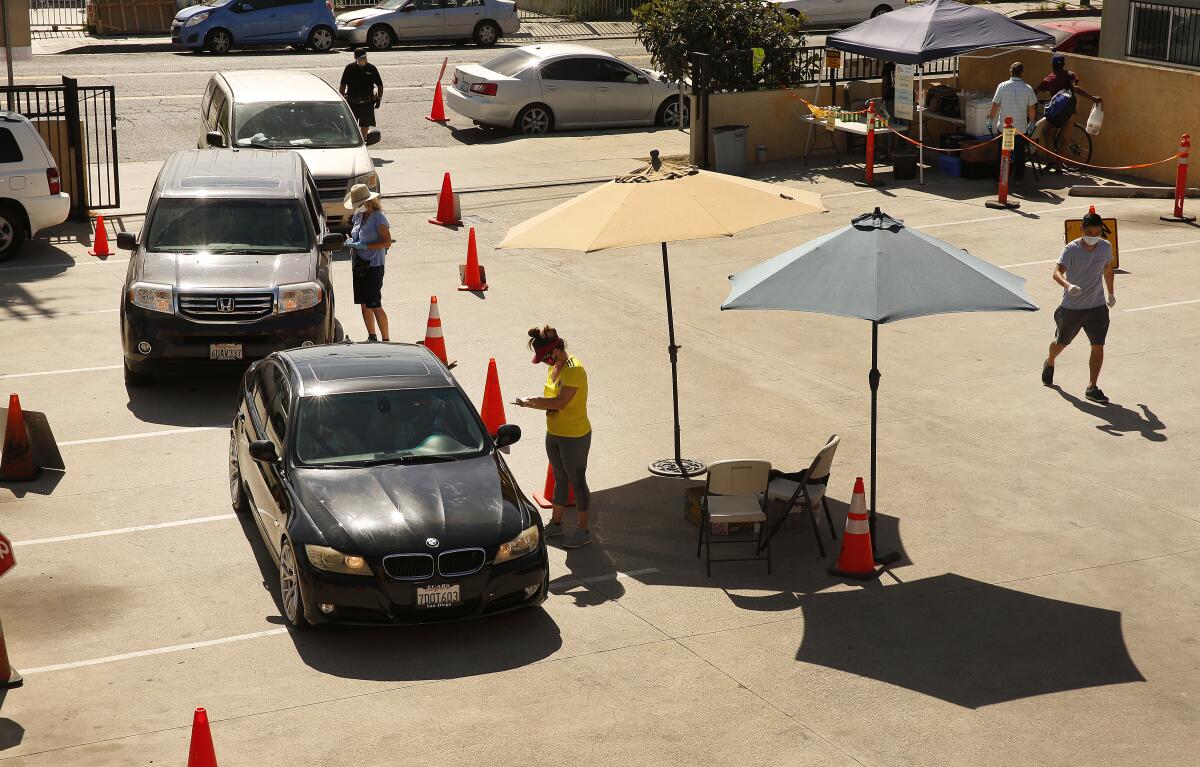
In its more than 150 years, the Salvation Army has supplied relief during tornadoes, fires and earthquakes. But this crisis, Chamness said, has been unlike any other.
“Typically our folks step in to give each other a break, but this time we’re all in it together,” he said. “There’s no passing the baton, and though the uncertainty of when this is all going to end is wearing on all of us, we have to find the energy to keep going.”
Beyond soaring demand, officials at food banks have been closely following the news about potential shortages of certain products, particularly meat after the closure of numerous meat processing plants.
Nick Vyas, the founding executive director of the Center for Global Supply Chain Management at USC, has been tracking supply issues since the pandemic erupted.
The coronavirus, he said, has created a perfect storm for potential food disruption, similar to what healthcare workers have experienced with shortages of personal protective gear.
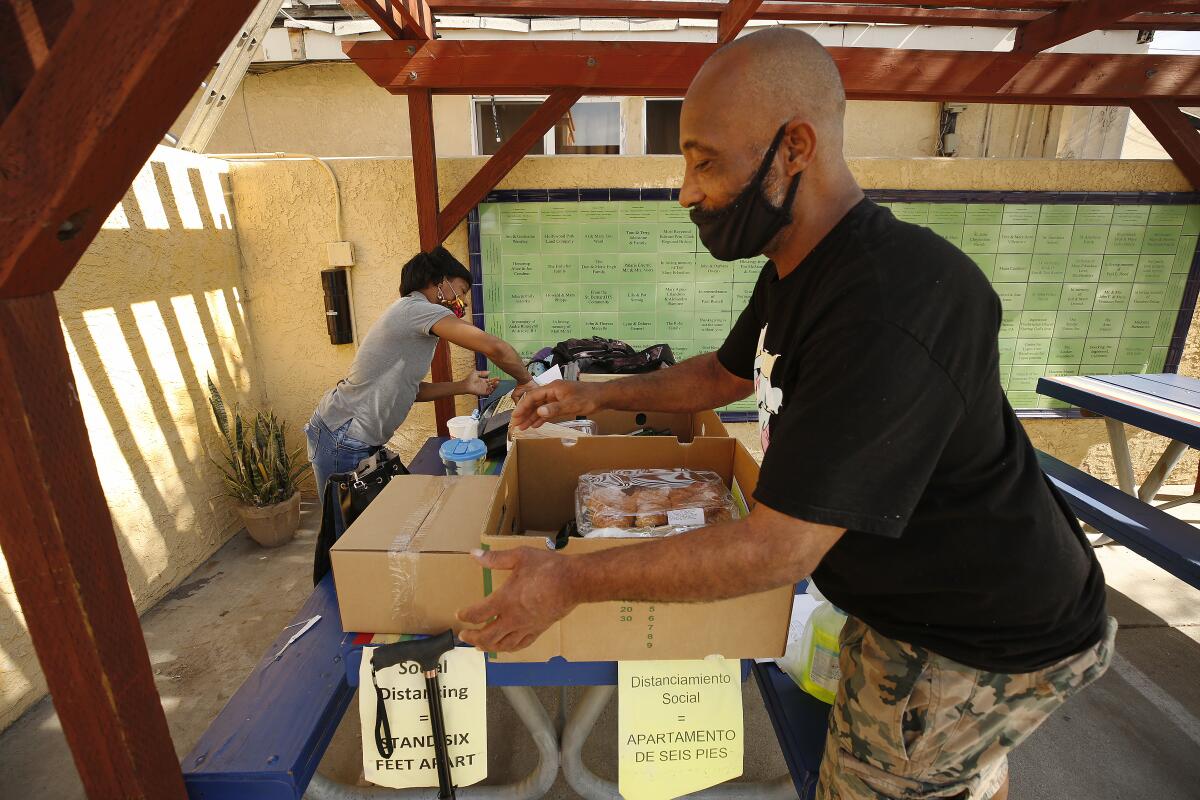
The combination of food hoarding, factory closures, supply-chain disruptions and record-breaking unemployment has put the food surpluses that so many food banks rely on at risk.
“We cannot afford to have these disruptions in the food supply while people are sheltering in place,” Vyas said. “That creates chaos in society.”
Another problem is farmers facing drop-offs in demand and distribution problems that make it logistically difficult or unprofitable to get their goods to market.
Vyas has spoken with farmers recently who have had to euthanize their piglets and dump vast quantities of milk because they can’t process their product.
“There’s too much regulation and liability for them,” he said. Vyas said he’ll team up with a task force of other supply chain experts, industry leaders and government liaisons in the coming weeks to address the issue.
At food pantries across L.A., officials know it’ll be some time before they see relief. However, many agencies already have begun to see scores of volunteers return under strict social distancing guidelines.
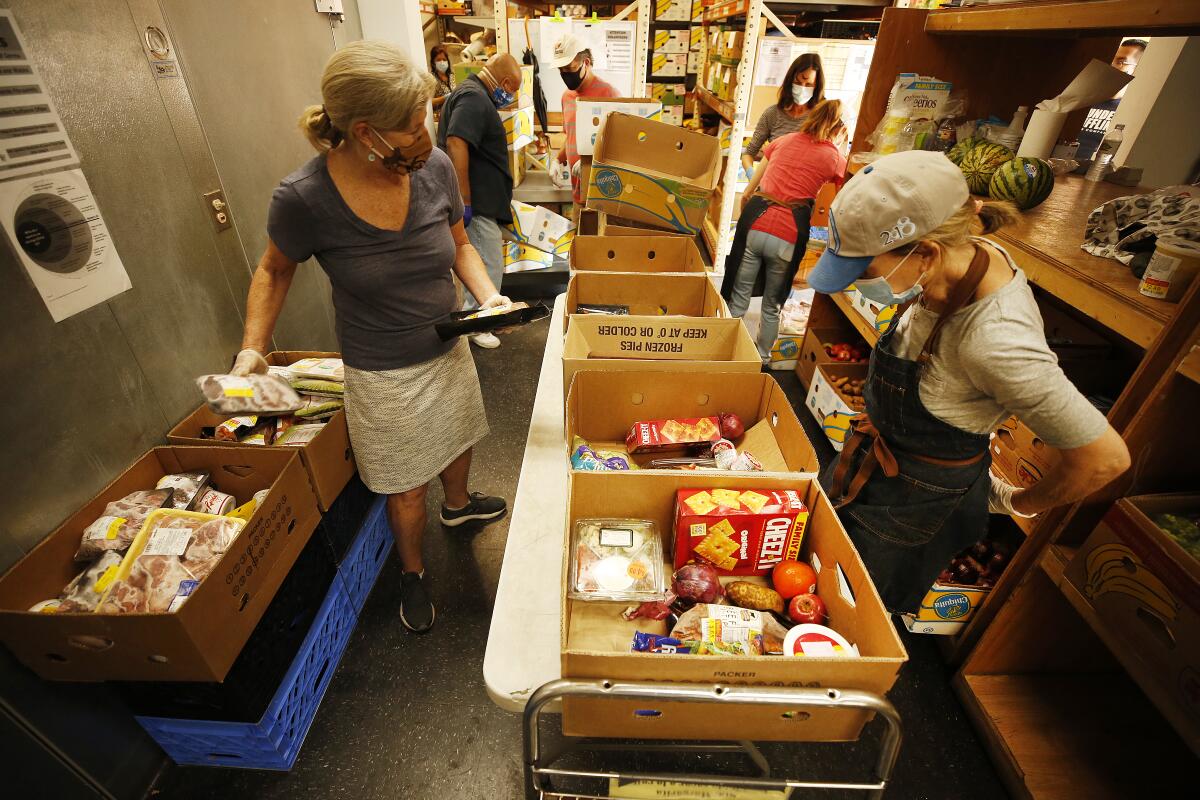
In El Monte, where the median household income is $39,000 a year, Our Savior Center was able to open a second food pantry for the community. Its client base has tripled to more than 2,000 people since the pandemic began.
“We’ve had incredible outreach from volunteers, many who have been deeply affected themselves by the crisis, but they come to help and stay connected,” said Executive Director Jane Fall.
In Lancaster, Stacey Cantwell and her team shifted from feeding 2,000 kids at the Antelope Valley Boys and Girls Club to feeding entire families at nearby schools. So far, the executive director said, her organization has helped distribute 4,000 meals to keep parents and kids fed over the weekend, days that aren’t covered by school meals.
At St. Margaret’s Center, an organization that provides everything from diapers to help with utility bills, families line up in cars to wait for food every Wednesday.
About 40% of those who come are new clients and most of them are Latino, many without a safety net, said director Mary Agnes Erlandson. Some are undocumented or married to someone who lacks legal immigration status, so they didn’t qualify for a stimulus payment. Others are unable to apply for unemployment, or their checks have yet to arrive.

Erlandson worries that even when those checks start arriving, the money will go toward paying overdue rent. Some families spend up to 90% of their income on shelter.
But even as the pandemic rages on and the financial challenges multiply, centers like St. Margaret’s continue to be a lifeline.
“We live day to day in this house,” Ofelia Jiménez said. “It’s all we’ve ever known. Every bit of help we get, we’re grateful.”
More to Read
Sign up for Essential California
The most important California stories and recommendations in your inbox every morning.
You may occasionally receive promotional content from the Los Angeles Times.














